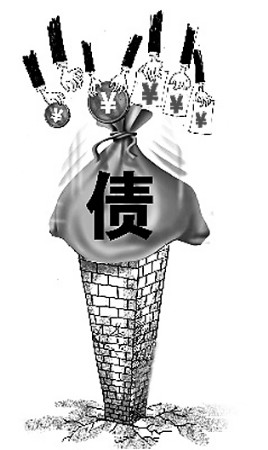4-trillion stimulus must attack infrastructure problems
- By Yi Xianrong
 0 Comment(s)
0 Comment(s) Print
Print E-mail China.org.cn, August 27, 2012
E-mail China.org.cn, August 27, 2012
|
|
|
?Yi Xianrong |
Cities like Ningbo (Zhejiang Province), Nanjing (Jiangsu Province), Changsha (Hunan Province) as well as Guizhou Province have issued series of plans for long-term regional development. Those investment initiatives have been spotlighted in the media for their connection to a new 4-trillion-yuan (US$629 billion) central government loan package to local governments.
Yet market concerns abound on whether the 4-trillion-yuan stimulus would be a replay of the twin-stimulus plan carried out by the central government in 2008. If these fears prove to be justified, what will the repercussions of adding 4 trillion yuan to the Chinese economy be? And even if such concerns are exaggerated, what sectors would the loans target? Also, how will the move influence China's economic growth and how will local governments channel the funds, via securities markets, banks or other institutions?
Additional questions abound: how will these mammoth investments break even, let alone achieve returns? Local governments are already mired in troubles concerning fundraising; how much additional debt can they continue to afford?
To answer the aforementioned questions, we need first to take two aspects into consideration:
First, despite China's slowing 7.8-percent growth in Gross Domestic Product (GDP) in the first half of this year, over 83 percent of local economies still enjoyed GDP growth of over 9.5 percent in the last six months, half of which were still surging at over 11 percent. The slowing national GDP growth rate is mostly due to downturns in four wealthy provinces and municipalities, including Guangdong, which composes a quarter of the nation's GDP as a whole. The figures show that growth in China's regional economies remains severely unbalanced.
Second, if China is about to close the urban-rural economic gap by lifting less-developed regions out of poverty, wouldn't this be a boon for potential growth? In 2010, the combined GDP for 11 provinces and municipalities was only 200 billion yuan more than the GDP of Guangdong Province, which registered 4.6 trillion yuan that year.
Yet the resources in those regions, whatever demographically, naturally or geographically, are 10 times richer than those of Guangdong. Just imagine how huge domestic demand would expand only if each of the provincial economies was on par with Guangdong.
Why are these regions lagging behind? The main reason is poor infrastructure, whether it be roads, railways, or urban facilities.
My travels to Zheng'an County and Tongzi County in Guizhou Province in contrast to my recent trip to Jianhu City, Jiangsu Province further support this theory. Each of the three counties, which contain approximately 800,000 people, vary drastically in their annual fiscal revenues: Zheng'an and Tongzi brought in 140 and 400 million yuan respectively while Jianhu netted 4 billion yuan.
In Guizhou, the vast inequities between neighboring counties can be mainly attributed to the infrastructure in place ― Tongzi is a traffic hub, whereas Zheng'an is surrounded by mountains with no highway access, making commerce logistically difficult. Jianhu County in Jiangsu, meanwhile, is a manufacturing base for petroleum products as well as machinery. One can only imagine the growth potential for China if Guizhou could catch up with Jiangsu.
Based on the above analysis, China's economy can continue to grow substantially, even boom, as long as the country takes advantage of the regions which are rich in natural resources and easy to live in. For less inhabitable areas, such as those with harsh geographic climates, development will still remain difficult, no matter how much money the government invests.
In other words, if possible, the government should finance the regions where the economies lag far behind while the environments are still habitable. If the central government increases its investments in the infrastructure of central, southwestern and northeastern China, it can pave the way for continued sustainable economic growth. It would be a pivotal way for the country to expand domestic demand.
Thus, we should not hastily comment on whether the 4-trillion-yuan local government stimulus package is good for the country or not. Its influence should be judged in terms of differentiated regional situations. On one hand, we need to caution against blind economic expansion by impulsive local governments, which could lead to subsequent financial and banking crises. On the other hand, we need to see infrastructure investments as the beginning of an economic surge for poverty-stricken regions such as Guizhou and Jiangxi provinces.
The central government should also change its system of investing in local governments. Previously, regional economies were financed by various financial and fiscal departments in Beijing. The government should instead transfer funds directly to the local governments to finance new infrastructure projects. In this way, the regional economies can receive an economic boost more quickly.
What we should be particularly concerned about is the sustainability of the local governments' said 4-trillion-yuan investment. Despite the current zeal for stimulus, the country must develop a long-term strategy for growth. We need to enhance the systems in place for managing and monitoring capital investments, reducing the chance of misuse by local government officials. In addition, we should also assess the possibility of financial crises which may result from this round of the investment, which could provoke local governments to obtain capital through illegal channels. This would not only raise the cost of regional fundraising, but potentially cause a chain reaction leading to subsequent future financial crises.
The author is the researcher at the Institute of Finance and Banking of the Chinese Academy of Social Sciences.
The article is first published in Chinese and translated by Wu Jin.
Opinion articles reflected the views of their authors, not necessarily those of China.org.cn.






